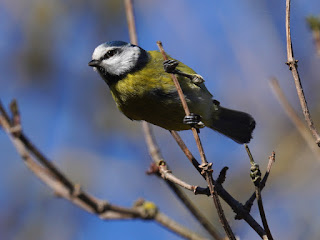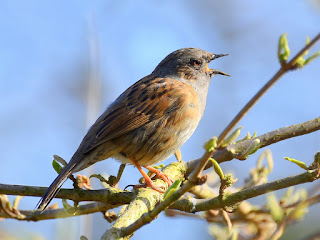A Reed Bunting has arrived, and was in a reed bed at the east end of the Lido. It's a male just beginning to get the black head of his breeding plumage. Thanks to Ahmet Amerikali for this picture.
A Wren searched for insects on the dead tree near the bridge.
So did a Long-Tailed Tit, or maybe it was looking for spider webs for its nest nearby.
Later one of the pair flew in with a good bundle of web.
A Blue Tit flitted around overhead.
A Pied Wagtail hunting insects on the Parade Ground was hampered by grass, so it couldn't sprint at the usual dizzying speed which makes it almost impossible to keep in the frame.
The Redwings are still here.
Magpies are pairing up. There were two side by side on the grass beside the leaf yard ...
... and a pair preening each other in a tree on the other side of the Long Water.
Another good picture by Ahmet: a Dunnock singing in Southwark Park.
The young Grey Herons in the nest on the island pestered a long suffering parent so much that it couldn't stand them any more and flew down to a quiet place out of their sight.
An interesting picture from Tinúviel: this White Stork colony on rocks at the Los Barruecos natural monument in Malpartida de Cáceres is unique in Europe. The strange granite rock formations fill their need to nest in a high and inaccessible place.
Two pairs of Great Crested Grebes were having a territorial dispute on the Serpentine and chasing each other around.
The male Mute Swan on the Long Water has cleared his territory completely, even throwing out last year's teenagers, so it's just him and his mate and they can get on with nesting.
It's not clear what the pair in the Italian Garden are going to do. If they come down on to the Long Water there will be a bitter fight because both the males are extremely aggressive even by swan standards.
A Tufted drake on the Serpentine stood tall to impress a female.
An early Small Tortoiseshell butterfly fed on some slightly withered crocuses in the Rose Garden.
There was also a Buff-Tailed Bumblebee that had survived the winter. It looked a bit dopey but could fly, and there were several kinds of flower nearby, so I didn't think it needed reviving with a drink of sugar water.














Very glad to see that Bumblebees coming out and thriving.
ReplyDeleteNow I wonder if Long Tailed Tits are afraid of spiders. Relative to their size some species must look quite large to them.
I think that's a Bumblebee that has survived since last year. They've been visible occasionally on sunny days throughout the winter. The Rose Garden has flowers of some kin d throughout the winter, so it's an idea place for them.
DeleteProbably Long-Tailed Tits get smaller spiders when they steal their webs, and simply eat them. The birds always seem to go for the skimpy strands spun by small spiders, and not the large webs of, say, Garden Spiders.
Re wrens in trees, were you able to verify they were Harlequin ladybirds in the tree in Tuesday's post?
ReplyDeleteYou might say that the evolutionary niche of most ladybirds involves their ability to feed on aphids and scale insects without constantly evading predators, betting on their chemical/aposematic deterrence of them and also their ability to hunker down tightly, though they may also face attack by ants protecting aphids. Red soldier beetles have some of these things in common. Jim
I can't say for certain that those were Harlequin Ladybirds, but on balance it seems likely, and Conehead 54 agrees. That picture was taken from a distance and no higher resolution is available, so you have the same information as I do.
DeleteGood to see you have a Reed Bunting back- a bird I see in small numbers at some of my local sites.
ReplyDeleteLovely to see the Magpie behaviour- a much maligned bird. I was watching a couple of pairs bickering on a nearby roof top.
Interesting to see the nesting White Storks- I normally see them on more anthropogenic sites.
I still haven't seen any butterflies yet but plenty of photos on FB. Lovely Small Tortoiseshell. Forecast this week looks like I'll wait a bit longer to see one.
I don't subscribe to the popular prejudice about Magpies. It seems silly to be kind to Jays and exclude them. All corvids are predatory to some extent but hey, it's a bird eat bird world and we live in it. Also they are great fun to watch.
DeleteWe have had a pair of Reed Buntings every year recently, usually seen around the largest reed bed below the Diana fountain,